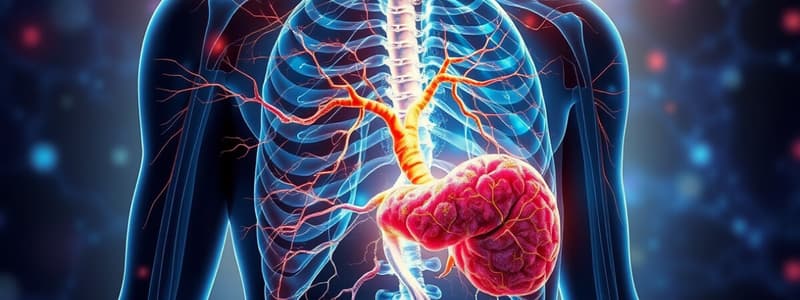Podcast
Questions and Answers
What are the two major branches of the nervous system?
What are the two major branches of the nervous system?
- Cerebral and Cerebellar
- Central and Peripheral (correct)
- Sympathetic and Parasympathetic
- Autonomic and Somatic
Who coined the terms homeostasis and 'fight-or-flight'?
Who coined the terms homeostasis and 'fight-or-flight'?
Walter Cannon
Which division of the nervous system does 'fight or flight' pertain to?
Which division of the nervous system does 'fight or flight' pertain to?
Autonomic NS
What does the ANS regulate?
What does the ANS regulate?
What are the primary organs of the ANS?
What are the primary organs of the ANS?
How do visceral reflexes differ from somatic reflexes?
How do visceral reflexes differ from somatic reflexes?
What are the components of the visceral reflex arc?
What are the components of the visceral reflex arc?
Describe an example of a visceral reflex.
Describe an example of a visceral reflex.
Describe the two divisions of the ANS.
Describe the two divisions of the ANS.
What maintains smooth muscle in the intestines and keeps resting heart rate in check?
What maintains smooth muscle in the intestines and keeps resting heart rate in check?
What maintains blood pressure and keeps most blood vessels partially constricted?
What maintains blood pressure and keeps most blood vessels partially constricted?
Describe the autonomic pathway.
Describe the autonomic pathway.
SEE figure ___
SEE figure ___
Flashcards are hidden until you start studying
Study Notes
Nervous System Divisions
- The nervous system is divided into CENTRAL and PERIPHERAL.
- Central nervous system includes the brain and spinal cord.
- Peripheral nervous system is further split into Sensory (visceral and somatic) and Motor (ANS and somatic motor).
Homeostasis Concepts
- Walter Cannon coined the terms "homeostasis" and "fight-or-flight."
Autonomic Nervous System (ANS) Overview
- The ANS is responsible for regulating fundamental life processes like heart rate, blood pressure, and body temperature.
- It controls glands, smooth muscle, and cardiac muscle.
Primary Organs of the ANS
- The primary organs include viscera of the thoracic and abdominal cavities.
- Also includes structures in the body wall, such as sweat glands and piloerector muscles.
Visceral vs. Somatic Reflexes
- Visceral reflexes operate slower than somatic reflexes and involve visceral effectors.
Components of the Visceral Reflex Arc
- Receptors detect various internal stimuli such as stretch, tissue damage, and temperature.
- Afferent neurons transmit signals to the CNS.
- Interneurons are located in the CNS.
- Efferent neurons carry signals away from the CNS to effectors that make adjustments.
Example of a Visceral Reflex: Baroreflex
- High blood pressure triggers arterial stretch receptors.
- Afferent neurons send signals to the CNS.
- Efferent signals act on the heart to slow it down, reducing blood pressure.
- This process exemplifies a homeostatic negative feedback loop.
Divisions of the Autonomic Nervous System
- The SYMPATHETIC division triggers the "fight or flight" response, increasing heart rate, blood pressure, airflow, and blood glucose levels while redirecting blood flow away from the skin and digestive tract.
- The PARASYMPATHETIC division facilitates "resting and digesting," lowering energy expenditure and promoting digestion and waste elimination.
Roles of ANS Tone
- Parasympathetic tone maintains smooth muscle activity in the intestines and regulates a resting heart rate.
- Sympathetic tone helps maintain blood pressure and ensures partial constriction of most blood vessels.
Autonomic Pathway Structure
- The autonomic pathway consists of two neurons that communicate at an autonomic ganglion.
- The signal must traverse a synapse where the two neurons meet before reaching the target organ.
Studying That Suits You
Use AI to generate personalized quizzes and flashcards to suit your learning preferences.




